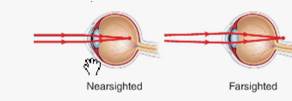
Concept explainers
The type of lens should a nearsighted and farsighted person use.
Answer to Problem 33SSC
Nearsighted person should use concave lens
Farsighted person should use convex lens
Explanation of Solution
Introduction:
If two spherical surfaces are joined in such a way that their reflecting surfaces are bent inwardly, the resulting lens is called concave lens. Concave lens deviates the ray of light incident on it and hence it is also called by the name diverging lens.
If two spherical surfaces are joined in such a way that their reflecting surfaces are bent outwardly, the resulting lens is called convex lens. Convex lens is also known as converging lens as it converges the ray of light passes through it and focuses it to a single point on the other side of that lens.
The given figure is shown below.

Figure 1
The concave lenses have the ability to reduce the focusing power of the eyes and hence they are commonly used to treat the nearsightedness. It can shift the light rays, focused to a point in front of the retina, backward to the surface of a retina. This resolves the blurred distance vision due to shortsightedness and gives clear vision to a person.
A farsighted person has very weak eye sight and the light rays are focusing behind retina at the backside of eyes as shown in the figure 1. If a farsighted person wear the convex lens, it causes bending of the light rays and helps to focus the light rays on the surface of a retina instead of behind it. Hence gives a clear vision for a farsighted person.
Chapter 18 Solutions
Glencoe Physics: Principles and Problems, Student Edition
Additional Science Textbook Solutions
College Physics: A Strategic Approach (3rd Edition)
University Physics Volume 1
College Physics
Essential University Physics: Volume 2 (3rd Edition)
University Physics Volume 2
Lecture- Tutorials for Introductory Astronomy
 College PhysicsPhysicsISBN:9781305952300Author:Raymond A. Serway, Chris VuillePublisher:Cengage Learning
College PhysicsPhysicsISBN:9781305952300Author:Raymond A. Serway, Chris VuillePublisher:Cengage Learning University Physics (14th Edition)PhysicsISBN:9780133969290Author:Hugh D. Young, Roger A. FreedmanPublisher:PEARSON
University Physics (14th Edition)PhysicsISBN:9780133969290Author:Hugh D. Young, Roger A. FreedmanPublisher:PEARSON Introduction To Quantum MechanicsPhysicsISBN:9781107189638Author:Griffiths, David J., Schroeter, Darrell F.Publisher:Cambridge University Press
Introduction To Quantum MechanicsPhysicsISBN:9781107189638Author:Griffiths, David J., Schroeter, Darrell F.Publisher:Cambridge University Press Physics for Scientists and EngineersPhysicsISBN:9781337553278Author:Raymond A. Serway, John W. JewettPublisher:Cengage Learning
Physics for Scientists and EngineersPhysicsISBN:9781337553278Author:Raymond A. Serway, John W. JewettPublisher:Cengage Learning Lecture- Tutorials for Introductory AstronomyPhysicsISBN:9780321820464Author:Edward E. Prather, Tim P. Slater, Jeff P. Adams, Gina BrissendenPublisher:Addison-Wesley
Lecture- Tutorials for Introductory AstronomyPhysicsISBN:9780321820464Author:Edward E. Prather, Tim P. Slater, Jeff P. Adams, Gina BrissendenPublisher:Addison-Wesley College Physics: A Strategic Approach (4th Editio...PhysicsISBN:9780134609034Author:Randall D. Knight (Professor Emeritus), Brian Jones, Stuart FieldPublisher:PEARSON
College Physics: A Strategic Approach (4th Editio...PhysicsISBN:9780134609034Author:Randall D. Knight (Professor Emeritus), Brian Jones, Stuart FieldPublisher:PEARSON





